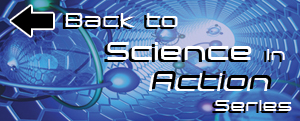
Andrew Whitley
Andrew Whitley is an enigma.
The classically trained Ph.D. just won the prestigious Charles Mann Award from the Federation of Analytical Chemistry and Spectroscopy Societies (FACSS) for his body of work. That includes his efforts in the field of applied Raman Spectroscopy, and his dedication to the continuation of the Raman spectroscopy program at the SCIX annual conference.
Yet, the man of science has another passion. It’s marketing, and his unique combination of business and technical skills have taken him down this parallel path. As HORIBA Scientific’s Vice President of Sales and Business Development, he aims to expand the universe of customers and applications for the company’s instruments.
It’s the second time a HORIBA scientist has won the award. In 2002, HORIBA Principal Scientist Fran Adar was so honored.
The humble Brit brushed away the recognition and tore into his real craving – finding new applications for current products, and finding new products for new and current applications.
“I made a decision in the early days not to go into research myself because I didn't want to get stuck in one area of research, and then you may do that for the rest of your career,” he said.
A broader perspective and his affinity for people influenced his decision.
“I was more interested in the bigger picture of helping other people in research, looking into the areas they do research, and enabling those people to be successful in what they are doing,” he said. “And I get to see and be involved in a much broader spectrum of research. I'm a people person, so I like interacting with, and enabling people.”
Whitley earned a Bachelor’s of Science in chemistry and a Ph.D. in vibrational spectroscopic studies from the University of Durham in the United Kingdom.
But he wanted to be involved in a wider view of science. He began his career with Bruker, a competitor of HORIBA’s. It was an experiment for Whitley. He didn't want to be a brochure regurgitater. He wanted to be someone who enabled people and provided them solutions, including the best instrumentation and methods for them to be able to achieve their research goals.
“I took the job as an experiment and I realized I was really good at it,” he said.
He was also good at building strong trusting personal relationships.
“I'm interested in the whole range of marketing, especially business development and product development,” he said. “Like with finding a need in the science community, in the pharmaceutical market for instance, and then seeing how we, as a company, can apply our expertise and our technology to solve that need and that problem.”
Whitley was providing existing equipment to address his customers’ needs in his early days at Bruker. Sometimes the company had to develop accessories, new applications, new software and new methodology to solve that customer’s challenges.
“But as time went by, I started leaning more and more towards the marketing needed to develop new or derivative-dedicated application products, using existing technology,” he said. “We have a goal; If we listen to the market needs, change the performance and interface, for example, you make it faster and develop special software to suit the customer's application requirements, it becomes very focused. One of the things I've been doing is a rebrand in recent times, the last four, five years. I’m looking to take general instruments and apply it to a dedicated application which is high volume.”
HORIBA’s Aqualog® is a good example. It was initially marketed to water treatment plants to measure dissolved organic matter in water, using our fluorescence A-TEEM (Absorbance–Transmission excitation-emission matrix) molecular fingerprinting method. But HORIBA saw an opportunity for the simultaneous absorbance and fluorescence spectrometer in wine and other industries. For example, juice and wine contain phenolic compounds, the concentrations of which effect taste, color, and fragrance. HORIBA realized the Aqualog could be used by analytical labs and larger wine manufacturers to investigate the components of their product and use it for quality control. The HORIBA team is in the process of developing separate but specific methodologies to provide actionable answers for the wine, water treatment and many other industries using this technology.
“I'm very interested in developing products for a dedicated need, like niche marketing, but also taking an existing platform and developing an application and a (standard operating procedure)” he said. “The Aqualog addresses a big market, and I’m expecting it to grow.”
Whitley divides his time between business development, sales and sales management. He has a team of sales managers with salespeople under them, and some product managers report to him as well.
That takes a bit over half his time. And during the rest, he’s looking for new opportunities for HORIBA.
“I'm really pushing and bringing to the company opportunities through collaborations, finding experts in a particular area,” he said.
An example is working with microplastics, tiny remnants of plastic five millimeters or smaller that seep into our ecosystem from mostly improperly discarded plastics. It became clear to Whitley that Raman and particle analysis is becoming a big application in this area.
“More and more people are using Raman and a microscope to look at and identify those small particles. And they want to automate the process,” he said. “So we’ve developed software called ParticleFinder™, which automatically finds where the particles are, counts them, gives you the morphology, the size, and shape, and then you automatically position the particles under the laser beam of the microscope.”
“Then you can identify the particles by measuring them with Raman, comparing to a library or doing multivariate analysis and determining how many different types of particles there are,” he said. “You’d do a library search on just those clusters of particles because it will have the same spectrum.”
The pharmaceutical industry is another opportunity in particle analysis for Whitley, in developing nanomaterials used in drug delivery mechanisms. Researchers need to know where the drug is going. Also, these particles in inorganic or biotherapeutic drugs shouldn’t clump or agglomerate in the delivery vehicle. It must be distributed evenly. Raman microscopy and imaging can help researchers develop reliable methods and solve problems that arise.
“Related to environmental and biomedicine studies there are a lot of opportunities in the future for HORIBA in Nanotoxicology,” he said.
Instrumentation companies provide an invaluable contribution to the growth of a technique and the science that is achieved through that technique, according to Whitley. As an analytical method, Raman is growing dramatically.
“Raman is a very powerful technique which offers a multitude of benefits that other molecular spectroscopy techniques do not,” he said.
Raman instruments are being used by forensic police departments to identify drugs, explosives and other substances. These substances can be measured through the container bag or bottle so the lab staff doesn’t have to remove them from their containers. That way, there's no question of evidence tampering.
And Raman has a real-world impact on everyday people.
Raman is used across the whole of the drug development process in pharmaceutical companies to help identify new drugs and deliver these to the patient. Biotherapeutic-type drugs have begun to take over in terms of drug discovery, according to Whitley. Manufacturers need to understand the molecules and molecular interactions. Some of the different forms of the drugs are more active than others. So the manufacturers need to understand all the different forms. Then they try all these different forms to see which one is the most active, with the least negative side effects, and the best performance. Then, each time the company manufactures the drug, its scientists need to know they made the right form.
Raman helps this process. The new methods for drug manufacturing, for example bioreactors, are crying out for methods to optimize production. We are applying Raman and fluorescence to these new manufacturing methods to help maximize yield and minimize costly errors.
“I want to continue to look for all these big opportunities where we can apply and tweak our instruments and methods, to make them perfect for these dedicated applications,” Whitley said.

Tiene alguna pregunta o solicitud? Utilice este formulario para ponerse en contacto con nuestros especialistas.